Menu
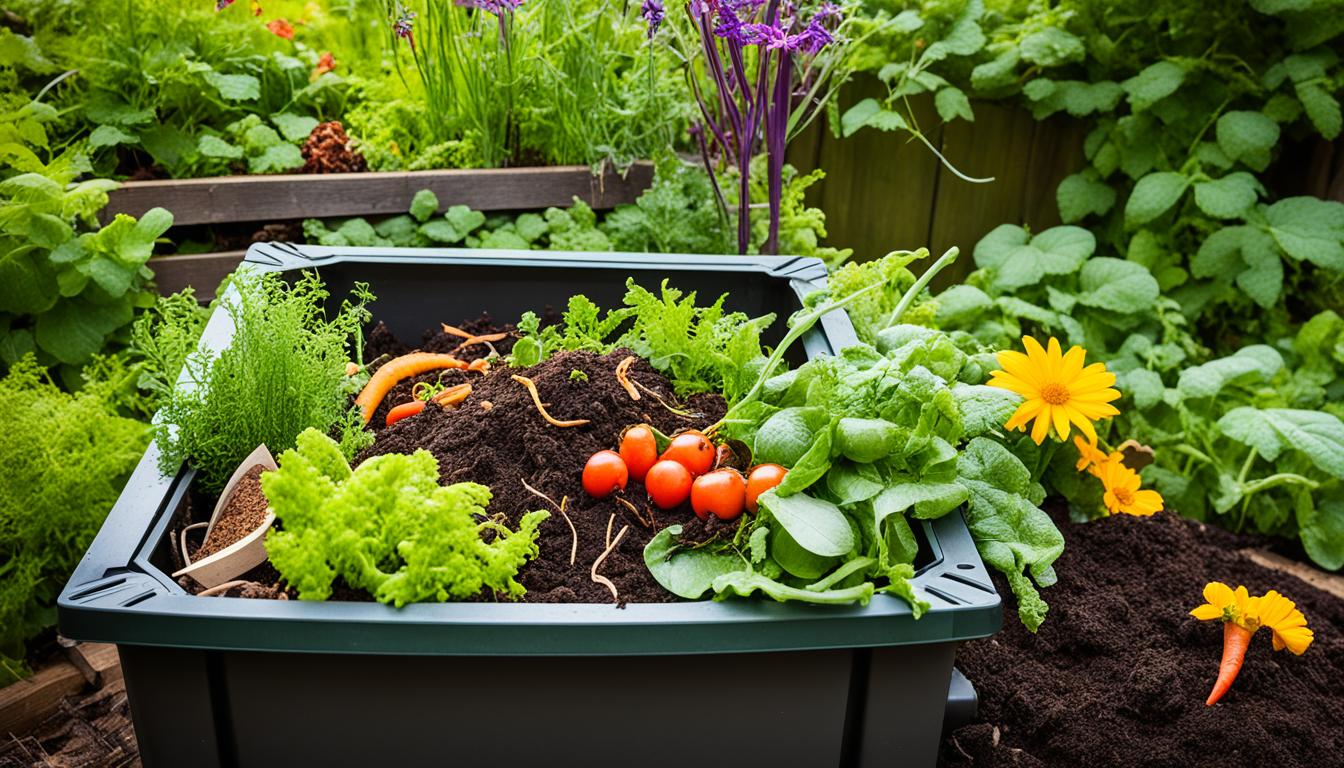
Did you know that in the United States, over 28 percent of thrown-away items are food scraps and garden waste? For all gardeners, improving soil is key, especially if it’s heavy clay or loose sand. Organic compost is crucial, boosting soil structure, helping it hold moisture, and providing nutrients.
Adding just an inch of compost twice a year can make a big difference. This kind of organic matter helps plants and soil organisms work together better. It creates a rich environment for gardening. With these composting ways, our gardens become more eco-friendly, embracing practices that help the soil thrive over time.
Organic compost is great for those who want to garden using eco-friendly ways. It’s made of decomposed natural matter. This includes things like food leftovers and old plants, creating a perfect environment for growing. Using organic compost cuts down on what we throw away, by about 28 percent.
Organic compost is made of pure materials. It’s chemical and GMO-free. This helps good microorganisms live in the soil. The secret is to mix ‘greens’ like fruit peelings with ‘browns’ like dry leaves. A good mix would be two to four parts brown to one part green. This mix shrinks in size as it breaks down, turning into rich nutrients for plants.
There are lots of good things about using organic compost:
Also, when we don’t manage waste well, it can produce a harmful gas called methane. Landfills are the third biggest source of this gas in the US. By recycling organic waste and composting correctly, we make the soil better and help our planet breathe easier.
| Aspect | Impact |
|---|---|
| Waste Generation | 1,600 pounds per person annually |
| Landfill Usage | 53% of total waste |
| Methane Emissions | Third-largest source from MSW |
| Food Waste in Landfills | About 22% of municipal discards |
| Soil Water Holding Capacity | Triple with 1% increase in organic matter |
We’re on a journey to find the best composting methods. We’ve discovered a range of ways that are both effective and eco-friendly. Let’s start with open air composting. It’s a slow process, taking 6 months to a year to make compost you can use. But, it’s loved by those who have a lot of space outdoors. This method slowly breaks down waste, improving soil health as it goes.
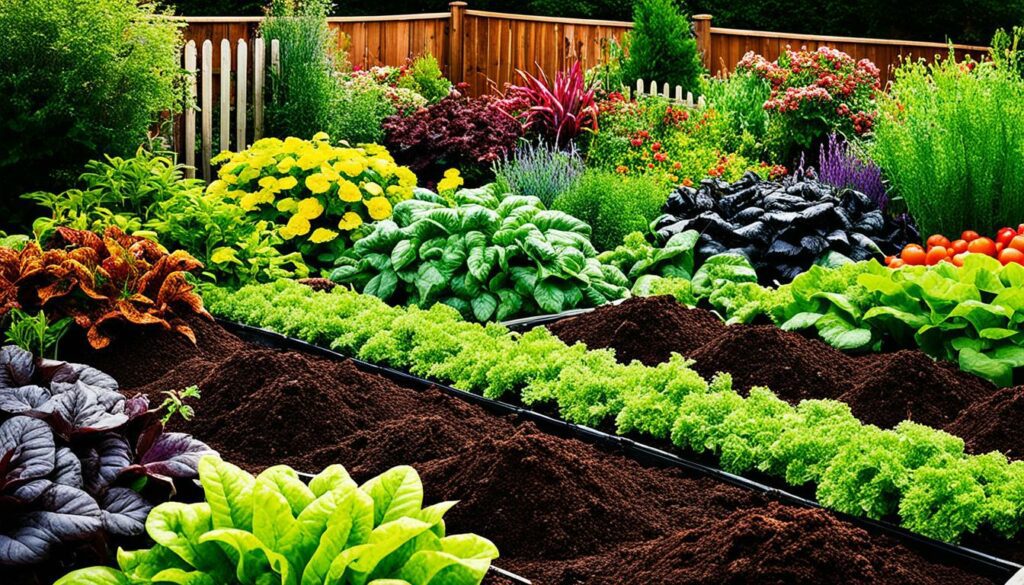
For faster results, there’s the Lomi electric kitchen composter. It turns food waste into compost in less than 24 hours, perfect for people wanting quick outcomes. Tumbler composting is also fast, needing about 12 weeks. But, remember to stop adding waste when it’s half full to ensure everything breaks down properly.
Inside the house, vermicomposting uses worms to speed up the composting process. It’s best for those who know a bit about gardening, as the compost it makes is especially nutritious. Keep the space at a steady 19°C for the best worm activity.
On the flip side, cool bin composting can take three years to finish. It’s a slow but easy way to compost. If you want your compost hidden, there’s trench composting. You bury your waste and it breaks down in a few months, out of sight.
There are also new and clever methods, like Bokashi composting. This approach treats food waste to stop it attracting pests. It’s great for small spaces. Indoor compost bins are also good for people who don’t produce a lot of waste. They’re perfect for city dwellers keen on composting.
There’s also sheet or lasagne composting. It fits well with No Dig gardening and is great for those with lots of grass clippings. You layer your compost with greens and browns, then top it with newspaper or cardboard. This creates compost slowly, but it’s very effective.
All these composting methods help cut down on the 108 billion pounds of food waste the US throws away each year. They also make soil healthier. Keeping our soil in good shape is key to a future filled with green gardening practices that are good for the planet.
Open air composting is a great way for gardeners to handle organic waste. It uses materials like wire cages and piping. This makes it an affordable and easy method for anyone to use. Let’s look at the benefits and challenges of open air composting. We’ll also show you how to start your own composting project.
In open air composting, a key element is aeration. This means the compost pile needs enough air for microorganisms to work properly. If there’s not enough air, the pile could start to smell bad. But, it’s very good at making nutrient-rich compost quickly because it decomposes fast.
Getting into open air composting is easy. First, pick a good spot that’s not too far away and drains well. Make a compost bay out of simple materials like wire cages. This keeps the compost airy. Always layer the pile with a mix of ‘greens’ and ‘browns’ for the best compost.
Turning the pile often keeps it from smelling bad. Also, the pile needs to be as wet as a sponge to help the microorganisms work. Toss in water, vegetable scraps, and a mix of carbon and nitrogen for top-quality compost.
| Composting Method | Benefits | Drawbacks | Time to Compost |
|---|---|---|---|
| Open Air Composting | Simple setup, low maintenance, nutrient-rich compost | Requires regular turning, attracts pests if mismanaged | Up to 2 years |
| Worm Farm Composting | Produces worm castings and compost tea | Toxicity issues with metal containers | 3-4 months |
| Tumbler Composting | Efficient, requires little space | Needs regular turning, multiple units needed | 3-6 months |
In-ground composting is a simple process. You bury organic waste straight into the ground. It is easy and great for gardeners who want a simple way to improve their soil.
To start, dig holes or trenches. Then, add things like fruit scraps, coffee grounds, and eggshells. Do not use meat or dairy to keep pests away. Cover the waste with soil to start composting in the ground.
This way, earthworms and other helpful organisms work on the waste. They make the soil better for plants. People who use direct composting see their soil and plants improve.
One big plus of direct composting is that it doesn’t smell or attract bugs. You can keep adding to the soil in raised beds all year. This will give you soil that is very good for your plants.
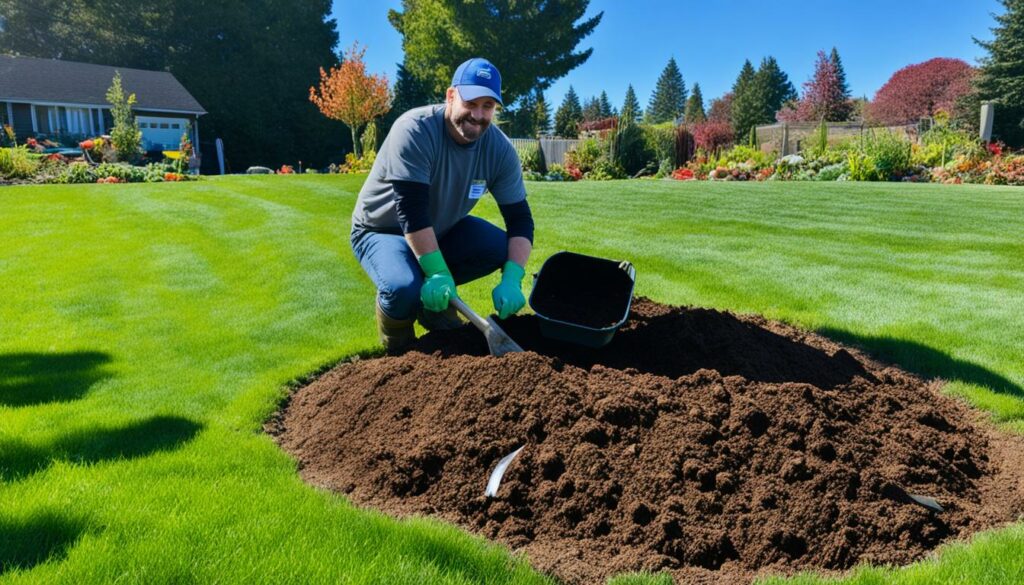
Plus, your soil gets better and better over time. Seeds will grow well and your plants will be strong. In the end, direct composting is a great way for both new and old gardeners to make their soil richer without the troubles of other composting.
Tumbler composting is great for people with small spaces but lots of organic waste. It uses a special container to make compost quickly. This way, you always have good compost for your garden.
When you pick a compost tumbler, think about its size and how it’s made. There are many sizes, from 37 gallons to 70 gallons. Choose based on how much waste you have. Look for a tumbler with two parts. This helps because you can keep adding new waste while the other side turns into compost.
To make compost well, remember these tips:
Using a compost tumbler can keep up to 30% of your household waste out of the trash. This makes your lifestyle more eco-friendly. Plus, it means you don’t need to use as much chemical fertiliser in your garden.
Practising these tips will help you make great compost and keep your garden healthy without too many chemicals.
The following table summarises key considerations for maintaining an effective tumbler composting system:
| Factor | Recommendation |
|---|---|
| Optimal Moisture Content | 40%-60% |
| Brown to Green Ratio | 3:1 |
| Tumbling Frequency | Every few days |
| Compost Activator Frequency | 2-3 times a year |
| Avoided Materials | Perennial weeds, diseased plants |
Follow these steps to keep your compost tumbler working well. This will give you nutritious compost and a thriving garden
Vermicomposting uses worms to turn food scraps into rich fertiliser. It’s perfect for homes and schools wanting to cut down on waste. It makes compost that’s great for plants and the soil.
Worm castings are full of nutrients plants need to grow. They make soil better, helping plants hold water and get more food. This helps plants in gardens, lawns, and farms thrive.
Worm castings also fight plant diseases and bugs, keeping gardens healthy naturally. You only need to collect them every 3-5 months. This makes the process simple, even for small spaces like homes and schools.
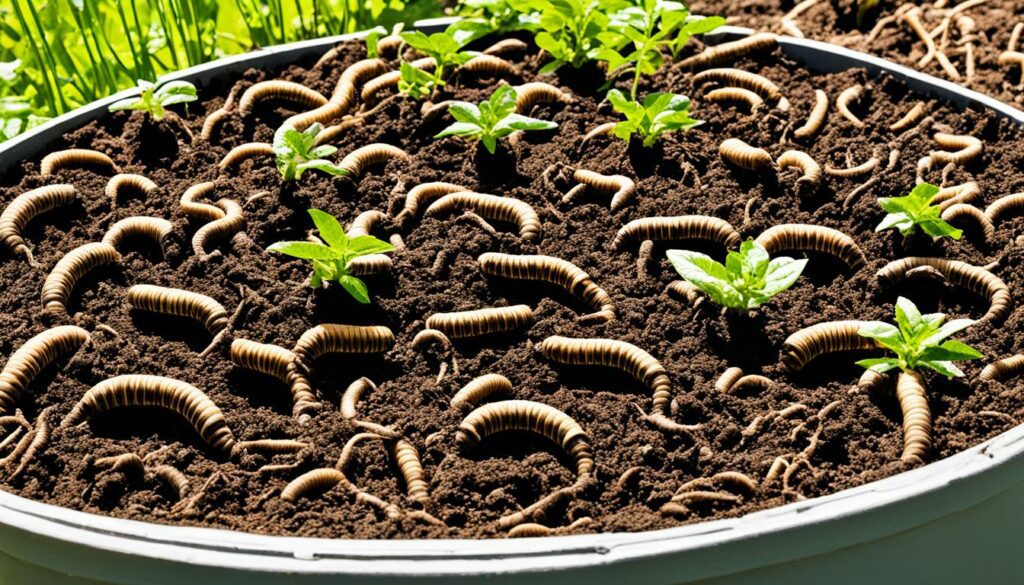
To start a worm farm, you need a big, shallow box that’s dark inside. Worms like it that way. Keep the soil slightly acidic, about 6.5 on the pH scale, for them to live well.
Feed the worms with fruit and veg scraps, not meat, oil, or dairy. The food should be as wet as a ‘wrung-out sponge’. In a year, you’ll have a lot of worms and lots of great compost.
Schools often use worm farms to teach kids about science and the environment. It shows students how to care for the planet. Plus, it reduces how much waste the school throws away.
“Vermiculture Technology: Earthworms, Organic Wastes, and Environmental Management” by CRC Press (2011) highlights how important vermicomposting is. It helps with waste and soil health, key for eco-friendly gardening.
EMO composting is a top way to deal with waste in a green manner. It uses good bacteria to turn organic waste into compost quickly.
The Bokashi system is a key example of EMO composting. It ferments food scraps using these special microorganisms, creating a compost supercharger. This rich mix helps plants grow. Because it’s done indoors, it requires some careful handling.
This method uses two containers. As one collects food scraps and does the composting work, the other is left to process things. This way, you’re always making compost.
Rotating mixers help keep things airy. The right mix of air and water is crucial for the bacteria to break down the waste well.
Changing to composting can cut our carbon footprint in half. It’s also a big help against the methane that’s bad for our air, coming from landfills. Plus, making your own compost can save money by cutting back on buying fertilisers.
For EMO composting to work well, it’s key to keep the right balance in the compost. The heat lets the bacteria work fast, turning waste into food for plants.
In short, EMO composting is a smart, effective way to turn kitchen scraps into a useful resource. It’s good for the planet, good for gardens, and good for saving money on waste disposal.
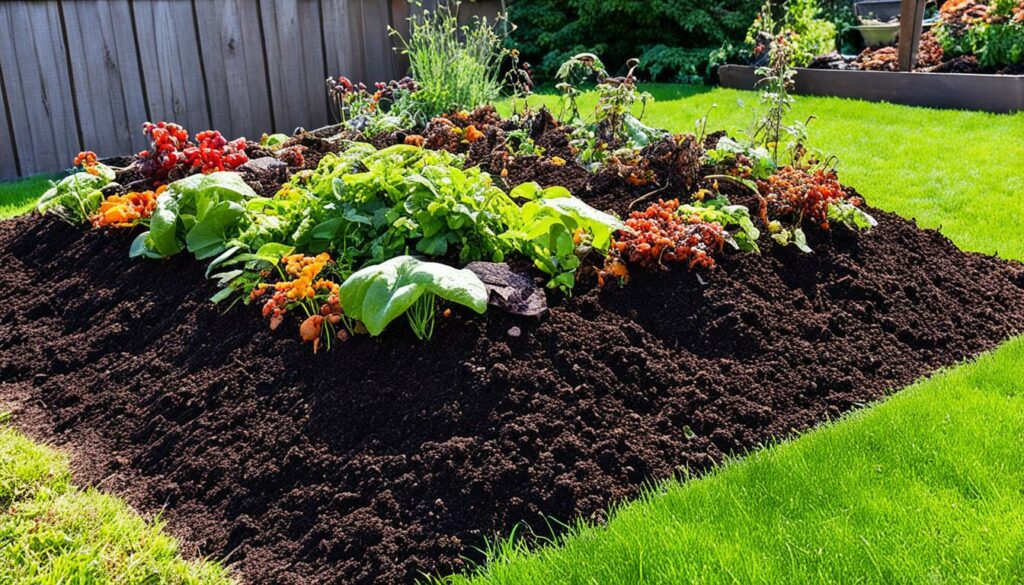
Diving into the world of combination composting reveals a shortcut to better gardening. This method mixes different ways of making compost. It uses everything from open-air composting to EMO, finding the perfect fit for each home. This not only helps reduce waste but also speeds up the process and boosts nutrients.
Combination composting is all about being flexible. It combines open-air, trench, tumbler, and EMO methods to meet any situation. Take the Compot, for example. It blends simple open-air composting with the benefits of worm and EMO composting. This mix handles various organic waste, cuts down time, and gives more nutrients.
For thriving, eco-friendly gardens, getting composting right is key. Blend different ways together to make the most of each. Adding worm farming helps break down organics quicker and adds beneficial worm castings to the soil. EMO composting manages indoor waste well. Together, these methods cut down on waste that would go to landfills. They also make the garden more productive.
Using a mix of composting methods changes how we manage waste and improve soil health. It means less work, fewer challenges, and better gardens. This approach is a win for anyone aiming for sustainable garden practices. Plus, the more we use and combine these methods, the more we help the planet.
| Method | Key Benefits | Considerations |
|---|---|---|
| Open-Air Composting | Low cost, high volume | Requires space, regular turning |
| Direct Composting | Direct soil enrichment | Slow process, attracts pests |
| Tumbler Composting | Efficient, less labour | Requires space, frequent turning |
| Worm Farm Composting | Rich castings, keeps pests out | Requires maintenance |
| EMO Composting | Indoor use, nutrient-rich | Needs specific microorganisms |
| Combination Compot | Efficient, reduces waste time | Integration of multiple methods |
Over the past decades, commercial composting has developed a lot. It has made huge steps forward since the 1980s. This has happened because many areas, from homes to big businesses, need better ways to deal with their organic waste.
To really understand industrial compost methods, it’s key to look at the four main ones. These are used for large-scale composting:
Commercial composting is great because it cuts down on harmful gases and lowers the use of chemical fertilizers. In places like New York, though, there are challenges like dealing with dirty waste. But, thanks to advanced tech for sorting, these problems can be solved. Educating people about composting is crucial for these projects to do well.
It’s surprising that organics make up the biggest part of US waste. This is a big issue that can be solved with more large-scale composting. These plants can take a lot of food waste, even things like bones and greasy cardboard. They help manage waste better, supporting a circular economy.
Now, with support from both private companies and local groups, we’re about to see big changes. These changes are towards handling organic waste in a more earth-friendly way, on a big scale.”
Getting the compost moisture right is key for good composting. The best moisture level is like a squeezed sponge. This helps things break down well and gives nutrients.
Let’s look at the signs and ways to keep your compost just right.
Checking if the compost is moist enough is easy. Try the Sponge Test. Grab a bit of compost and squeeze it. It should feel like a damp sponge to be just right, around 40% – 60% moisture.
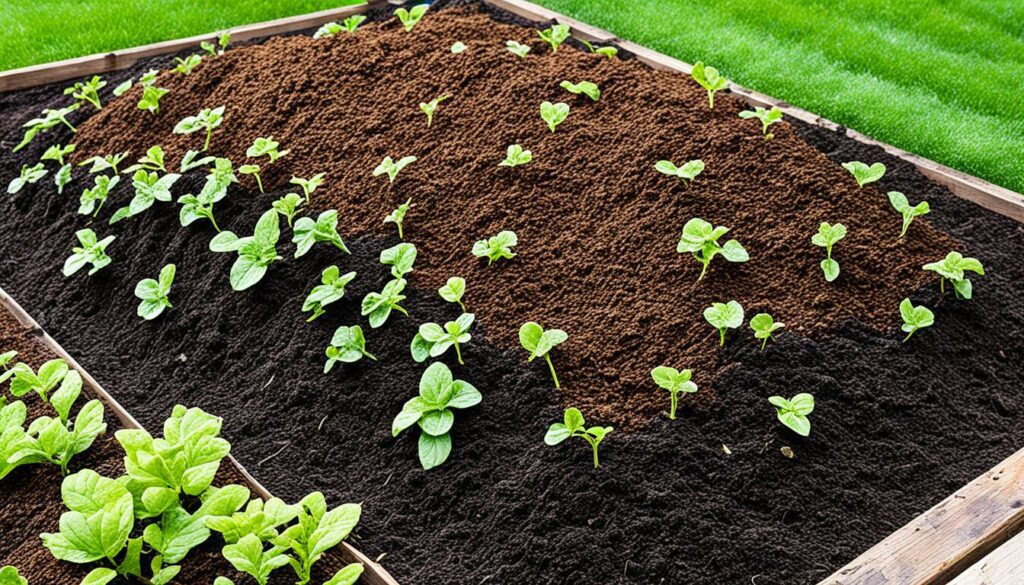
If the compost is too dry, you’ll notice it’s not breaking down or producing heat. This means microbes can’t work well. But, if it’s too wet, it gets slimy, smelly, and may have an ammonia smell. This tells you it’s breaking down poorly without air.
To keep the moisture perfect, you need to manage it well. Here’s how:
Using these tips helps gardeners make the perfect home for breaking down scraps into plant food. Getting the moisture spot on makes composting work better. It gives you a super plant-friendly soil in the end.
Choosing the right materials for your compost is key. You need a mix of ‘greens’ and ‘browns’ for the best results. The right balance gives microbes nitrogen and carbon. This helps them break down the material quickly. A good mix is 2:1 to 4:1, but balance is best.
Greens, like veggie scraps and grass, have nitrogen. Browns, such as leaves and cardboard, offer carbon. This balance is vital for proper composting. Also, ensure your compost is as damp as a ‘wrung-out sponge’ for it to work well.
Turning the compost pile frequently can make it ready in only a few weeks. If you only turn it a few times each season, it could take 8 months to finish.
The size of your compost pile matters too. A hot compost pile should be between 3’x3’x3′ and 5’x5’x5′. Bigger piles often work better. Expect the pile to reduce to a third of its size as it breaks down. So, keeping it moist and well-aerated is crucial.
| Do’s | Don’ts |
|---|---|
| Use equal parts of browns and greens | Avoid adding meat or bones |
| Maintain moisture, similar to a wrung-out sponge | Do not include harmful weeds |
| Turn the pile occasionally | Avoid adding large branches or logs |
For quicker breakdown, chop your compost items small. This speeds up the process. It might also be wise to keep animal products out of smaller compost systems to stay away from pests. By following these steps closely, you’ll make top-notch compost that helps your garden and cuts down on waste.
Creating homemade compost lets us recycle food scraps and enrich our garden soil. It’s easy if you stick to some key steps. These include setting up the best compost bin and layering compost materials correctly.
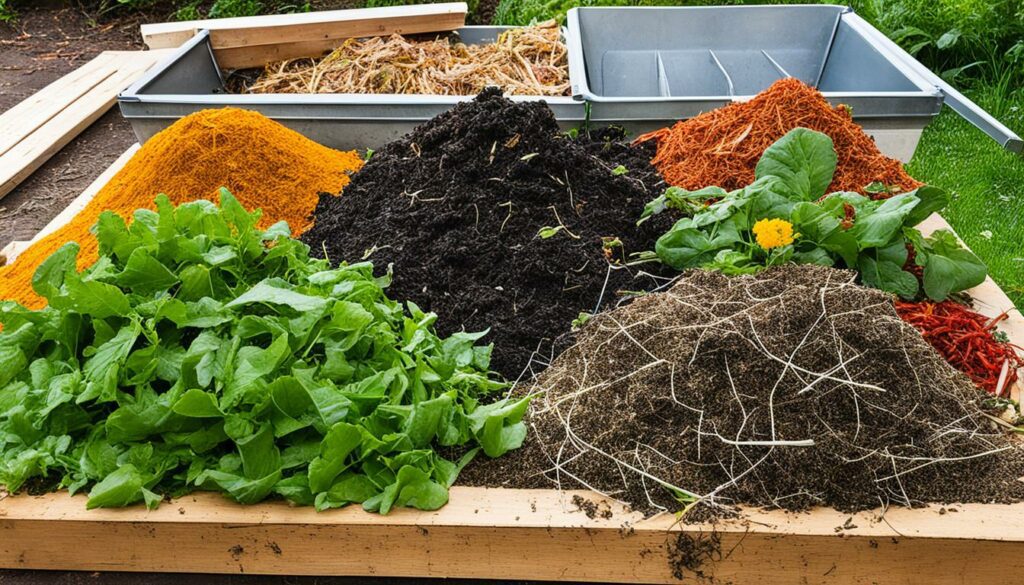
Choosing the right bin is the first step in making homemade compost. You can buy one or make it yourself from old stuff. It’s important the bin lets in plenty of air for composting to happen. The U.S. EPA says almost 60% of waste is compostable, so make sure your bin is big enough.
Layer your compost materials properly. You need to get the balance right between carbon-rich and nitrogen-rich items. Carbon comes from things like dried leaves and paper. Nitrogen is in food scraps and grass clippings. Aim for a C:N ratio between 25:1 and 40:1.
After a while, your compost should show a C:N ratio of around 20-25:1. Its volume should be reduced by half or more. With the proper steps, your homemade compost will be ready in about two months. It will help your soil and plants by keeping nutrients stable after a couple of weeks of curing.
Sustainable composting helps to cut down on waste. The USA sends about 136 million tons of waste to landfills each year. Around 22% of this is food scraps. By composting, we can reduce this waste. It also helps with organic gardening and puts nutrients back into the earth.
Sustainable composting is good for the planet in many ways. It helps to lower the amount of methane gas from our landfills. Food scraps and garden waste, when composted, reduce these harmful emissions. San Francisco’s composting has kept 80 percent of its waste from landfills. This has stopped around 90,000 metric tons of carbon emissions each year since 2012.
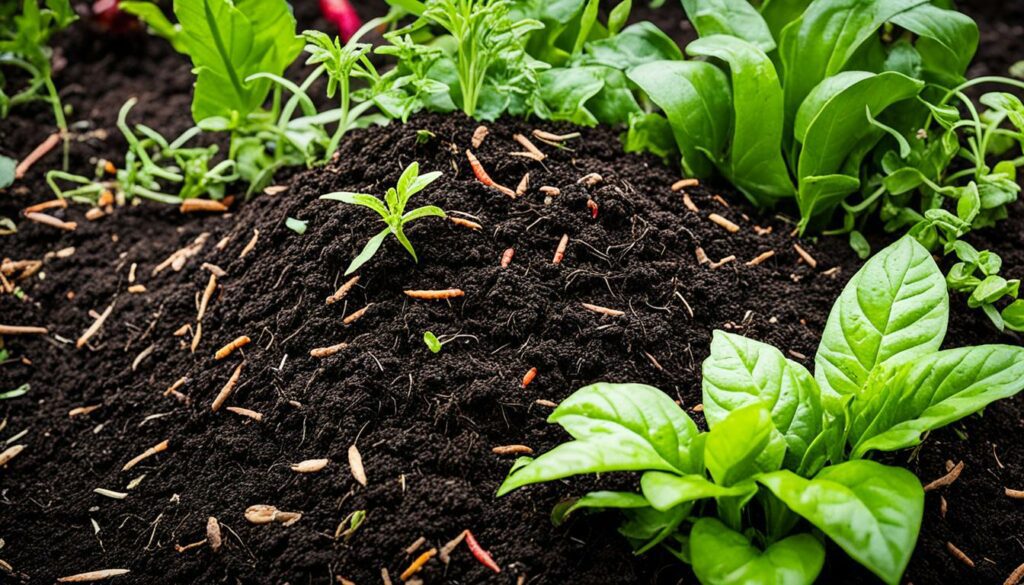
Composting is great for organic gardening. It makes the soil better by adding nutrients and improving its structure. Today’s farming has made soils less healthy over time. But compost brings back nutrients naturally. It also attracts helpful creatures and tiny organisms. This helps the plants grow strong and healthy.
Composting also helps save water. Adding just one percent more organic matter to the soil can make it hold three times more water. Since farming uses so much water, this is very important. Every one percent organic matter increase means the soil can keep 20,000 more gallons of water for every acre.
Lots of money is wasted on throwing away food. An average American family of four throws away about $150 of food every month. The most wasted food is fresh fruits and vegetables. But when we compost, this food turns into something helpful. It becomes compost that we can use to make our gardens better, and it doesn’t clog up landfills.
| Benefits | Impact |
|---|---|
| Waste Reduction | 136 million tons annual waste directed away from landfills |
| Methane Emission Reduction | Lower emissions from MSW landfills – the third-largest emitter in the U.S. |
| Enhanced Soil Composition | Slow-release nutrients and soil structure improvement |
| Water Conservation | Increased water retention with higher organic matter in soil |
| Economic Savings | Decreased food waste financial loss – $150 per month per family |
Adding sustainable composting to our lives has many environmental benefits. It also makes organic gardening better. When we adopt these green ways, we help our planet. We make it possible for a healthy ecosystem and future.
We’ve reached the end of our detailed look at organic composting methods. It’s clear that these methods bring many benefits to our gardens. They improve soil’s quality and its ability to hold water. They also help fight off diseases. You can choose from eight methods, such as open-air composting or using a worm farm. Each fits different living situations and helps the environment.
Vital things like air, water, and the mix of carbon and nitrogen are key to composting. Having good bacteria, worms, and soldier flies around is also important. It doesn’t matter if you go for simple ways or something new, like EMO composting. What’s crucial is knowing how to work with these elements for the best results. Every method has its good and bad points. It’s important to think them through to get the best results.
Commercial composting is big, efficient, and quick, with high-quality nutrients. Companies like McLeod’s Agriculture tell us it’s better to choose quality over price. This shows that good compost costs more but it’s worth it. Using organic compost is key for green gardening and keeping soil healthy. This way, we avoid harming the environment and save money. Let’s keep supporting and using these methods. They make our planet better and more sustainable for the future.
Organic compost comes from natural materials. This compost is made without any synthetic chemicals. It works well to better soil, keep moisture, and add nutrients. It’s a big part of gardening that’s good for the planet.
Using organic compost makes soil better. It helps plants grow well by working with friendly soil germs. It also makes sure plants get the food they need. This helps our world by reusing what we normally throw away.
There are many ways to make organic compost. You can do it in the open, in the ground, or by turning it in a special bin. Worms are also great at making compost. People even use special microorganisms for this. Each way is good for different places and needs.
Making compost in the open is easy and free. It happens through natural air and water. But, in cold areas, it might not work well. It can also get smelly and attract animals if not kept right.
Start by placing a mix of carbon-rich and nitrogen-rich materials on the ground. Keep turning it and adding water as needed. Use old leaves and manure to make it work faster.
Direct composting means putting kitchen scraps right under the soil. This helps the soil and encourages worms. But, it takes time and you have to watch for pests.
When picking a compost tumbler, think about your garden and how much rubbish it gets. If you have a lot, you might need more than one. This will make the compost faster.
For tumbler composting, use a mix of fresh and dry plant waste. Keep turning the tumbler and check that it’s wet enough. This method is great for small gardens with lots of waste.
Worm castings are great for plants because they’re full of food. They help the soil hold water and make room for good soil life. This is a top choice for looking after a garden well.
To start a worm farm, you need a special box and a place for the worms to be happy. Don’t use metal. Feed them bits of fruit and veggies often.
EMO composting uses helpful tiny living things to turn rubbish into food for plants. People do this inside with a special system called Bokashi. This way is great for getting strong plant food.
Mixing different ways of making compost lets you use what’s best at home. This can cut down garbage and make really good compost for the plants.
Big compost places deal with more and different types of waste. They make sure the compost has lots of good stuff for plants. They often do this in long rows outside.
Good compost feels like a sponge that’s just damp. To keep it this way, layer your compost and cover it. This keeps the water just right.
To make good compost, mix fresh and dry plant matter. Don’t put in meat or nasty weeds. This stops pests and helps everything break down well.
Make sure your compost bin has holes and good layers. Start with dry things, then add wet. Keep repeating this to make a good, rich compost place.
Doing compost well saves the earth by using less rubbish, making gardens better, and keeping plant food going in a loop. It’s very kind to our environment.